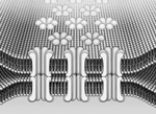Correct Answer

verified
50% for correctly labeling at ...View Answer
Show Answer
Correct Answer
verified
View Answer
Multiple Choice
Which of the following is a passive process that acts to distribute ions evenly in neural tissue?
A) random motion, which tends to move ions down their concentration gradients
B) electrostatic pressure, which forces ions down their electrostatic gradients
C) sodium-potassium pumps, which distribute Na+ and K+ ions equally
D) both A and B
E) both A and C
Correct Answer

verified
Correct Answer
verified
Multiple Choice
Which neurotransmitters are often released from string-of-beads axons?
A) monoamines
B) amino acids
C) glutamate and GABA
D) soluble gases
E) peptides
Correct Answer

verified
Correct Answer
verified
Multiple Choice
Serotonin is synthesized from
A) tyrosine.
B) L-DOPA.
C) tryptophan.
D) norepinephrine.
E) epinephrine.
Correct Answer

verified
Correct Answer
verified
Multiple Choice
After release, most neurotransmitters are deactivated by
A) reuptake.
B) synaptic enzymes.
C) the postsynaptic receptors.
D) deactivating enzymes.
E) ribosomes.
Correct Answer

verified
Correct Answer
verified
Multiple Choice
Which of the following are membrane potentials?
A) EPSPs
B) IPSPs
C) APs
D) all of the above
E) both A and B
Correct Answer

verified
Correct Answer
verified
Multiple Choice
Which of the following is currently thought to be a valid general principle of synaptic transmission?
A) Each neuron releases only one neurotransmitter.
B) Each neurotransmitter acts on only one receptor subtype.
C) All receptors are in postsynaptic membranes.
D) All neurotransmitters are released into the synaptic cleft.
E) none of the above
Correct Answer

verified
Correct Answer
verified
Multiple Choice
The conduction of an action potential along any axon is mediated by the action of
A) nodes of Ranvier.
B) voltage-activated ion channels.
C) ligand-activated ion channels.
D) myelin.
E) EPSPs.
Correct Answer

verified
Correct Answer
verified
Multiple Choice
In comparison to metabotropic receptors, ionotropic receptors produce effects that
A) are less diffuse.
B) develop more rapidly.
C) are more enduring.
D) all of the above
E) both A and B
Correct Answer

verified
Correct Answer
verified
Multiple Choice
 -Illustrated here is
-Illustrated here is
A) an axon hillock.
B) a synapse.
C) a gap junction.
D) a dendritic spine.
E) none of the above
Correct Answer

verified
Correct Answer
verified
Multiple Choice
Action potentials begin by the
A) opening of voltage-activated sodium channels.
B) closing of ligand-activated chloride channels.
C) closing of ligand-activated potassium channels.
D) opening of ligand-activated potassium channels.
E) closing of voltage-activated calcium channels.
Correct Answer

verified
Correct Answer
verified
Multiple Choice
Atropine is
A) an extract of opium.
B) a cholinergic agonist.
C) a muscarinic antagonist.
D) a pupil constrictor.
E) a catecholamine.
Correct Answer

verified
Correct Answer
verified
Multiple Choice
A change in the resting potential of a dendrite from -70 mV to -72 mV is called
A) an IPSP.
B) an EPSP.
C) a depolarization.
D) both A and C
E) both B and C
Correct Answer

verified
Correct Answer
verified
Multiple Choice
APs are said to be all-or-none: This means that all APs
A) are the same.
B) in a particular neuron are the same.
C) travel at the same speed.
D) all of the above
E) both A and C
Correct Answer

verified
Correct Answer
verified
Multiple Choice
Active transmission is to passive transmission as
A) IPSPs are to APs.
B) EPSPs are to IPSPs.
C) APs are to EPSPs.
D) EPSPs are to APs.
E) excitation is to inhibition.
Correct Answer

verified
Correct Answer
verified
Multiple Choice
Glial cells have been shown to
A) release chemical transmitters.
B) contain receptors for neurotransmitters.
C) conduct signals.
D) participate in neurotransmitter reuptake.
E) all of the above
Correct Answer

verified
Correct Answer
verified
Multiple Choice
The receptors of the neuromuscular junction are
A) cholinergic.
B) nicotinic.
C) muscarinic.
D) both A and B
E) both A and C
Correct Answer

verified
Correct Answer
verified
Multiple Choice
There is only one neurotransmitter that is known to be deactivated in the synaptic cleft by enzymatic action; this neurotransmitter is
A) dopamine.
B) acetylcholine.
C) acetylcholinesterase.
D) norepinephrine.
E) glutamate.
Correct Answer

verified
Correct Answer
verified
Multiple Choice
Neuropeptides are transported from the cell body to the buttons at a speed of about
A) 100 meters per minute.
B) 40 centimeters per day.
C) 60 meters per second.
D) 40 meters per hour.
E) 20 meters per second.
Correct Answer

verified
Correct Answer
verified
Multiple Choice
Ionotropic receptors are linked to
A) ribosomes.
B) neurotransmitters.
C) ligand-activated ion channels.
D) vesicles.
E) G proteins.
Correct Answer

verified
Correct Answer
verified
Showing 41 - 60 of 152
Related Exams